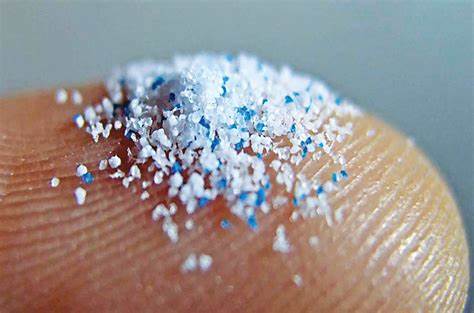A new meta-analysis has clarified the serious damage microplastics can do to mammalian reproductive function.
The new study, published in the journal Life Sciences, is yet further evidence of the dreadful toll these miniscule pieces of plastic — which are more or less everywhere you care to look in the modern world — are having.

Microplastics: pervasive reproductive damage in mammals

The study is the first attempt to draw together all existing evidence for the reproductive effects microplastics have been documented as having in mammals.
The results are unequivocal: microplastics accumulate in the reproductive organs of mammals where they cause pervasive reproductive damage.
“These studies indicated that PP can accumulate in the gonads, triggering seminiferous degeneration, Sertoli cells death, blood-testis barrier disruption, sperm degeneration, malformation, reduced number and mobility, ovarian cysts, reduced follicular growth and granulosa cells death.
Gonadal damage was associated with upregulation of prooxidant mediators (oxygen reactive species, lipid and DNA oxidation), cell death, proinflammatory molecular pathways and cytokines, as well as inhibition of enzymatic and non-enzymatic antioxidant defense mechanisms.
Spermatogenesis, folliculogenesis, testosterone, progesterone and estrogen levels were also impaired in PP-treated animals, which were potentially associated with down-regulation of molecules involved in germ cells microstructural organization (occludin, N-cadherin, β-catenin and connexin 43) and steroidogenesis, such as hydroxysteroid dehydrogenases, steroidogenic acute regulatory proteins, follicle stimulating and luteinizing hormones.”
Exposure to polystyrene microplastics leads to reduced testosterone, reproductive problems in mice

In January we reported on an individual study of the effects of polystyrene microplastics on the reproductive systems of mice.
The study of mice showed that the effects, while serious in males, were even more serious in females.
The new study, conducted at Central China Normal University, focused on the effects of microplastic exposure on hormone levels and fertility among mice.
In this study, male and female C57BL/6 mice were exposed to saline or 0.1 mg/d polystyrene microplastics for 30 days or 44 days.
Some of the mice were then caged for 10 days to mate to test fertility.
Another group of mice were given fluorescent polystyrene microplastics to determine the accumulation of microplastics.
Click here to read more about this worrying study
The broader perspective on microplastics
This should sound scary, because it is.
Although this new meta-study is not of humans, the implications for us are clear. Further research into the effects of microplastics on human reproduction and health must be a priority.
It’s already well known that microplastics are carriers of toxic xenoestrogens, industrial chemicals that have disastrous gender-bending effects.
These chemicals are believed to be one of the principal causes of a calamitous decline in fertility that could bring about the end of human reproduction as we know it.
By 2045, according to Professor Shanna Swan, the majority of men may no longer be able to reproduce because of the effects of harmful chemicals from a variety of common household sources.
“We’re about 40 years behind global warming, in terms of awareness,” she says – yet the threat to human survival is just as great as, if not greater than, our concerns about greenhouse gas emissions.
According to Swan’s projections from the available data, by 2045 the sperm count of the median man will reach zero – meaning that one half of all men will have no sperm at all, and the other half will have an amount that is barely more than zero. Functionally, all men will be infertile.
The implications should be obvious: no sperm, no babies. Such a scenario has already been dubbed ‘Spermageddon’.
But it’s not just xenoestrogens that are responsible for the precipitous decline in male fertility we’re witnessing. Swan also points to a variety of other factors that seem to be at work, including the use of contraceptives, obesity, smoking and ‘cultural shifts’, a rather vague term which would deserve further explanation.
Could it be that as men behave – or are given less room to behave – in less stereotypically manly ways, they may actually become so?
There may be other biological factors at work too, she suggests, pointing to the collapse in testosterone levels in western men over the last half century.
While a reduction in testosterone levels is a fact of life for all men as they age – after the age of 30, a man can expect to lose 1% of his natural testosterone every year for the rest of his life – this natural reduction pales in comparison with the society-wide collapse in T levels that has occurred over the second half of the twentieth and the first quarter of the twenty-first century.
Men today have considerably less T than men of the same age even a single generation ago. A 2007 study in the Journal of Clinical Endocrinology and Metabolism showed a significant reduction in the T levels of men since the 1980s. A 60-year-old American man in 2004, for example, had 17% less testosterone than a 60-year-old American man in 1987.
While the collapse of testosterone is likely to be linked to the ubiquity of the xenoestrogenic chemicals Swan warns about, sedentary lifestyles and the consumption of phytoestrogens are also likely to be playing a large role.
All in all, it adds up to a witch’s brew of environmental, social and biological factors that are making it ever harder for men to maintain their masculinity and fulfil their biological purpose.


Don’t hesitate to email us at [email protected] for personalized coaching and a client questionnaire if you’d like DEDICATED tailor-made personal training on strength training, building muscle, losing fat, developing athleticism, and more — all to your liking, lifestyle, habits, and taste!
Otherwise, don’t forget to claim your FREE eBook detailing how to lose 20lb of fat while building muscle in 12 weeks! You can claim it here.
Alternatively, you can pick up a FREE eBook on fundamental strength principles offering an introductory workout program.











